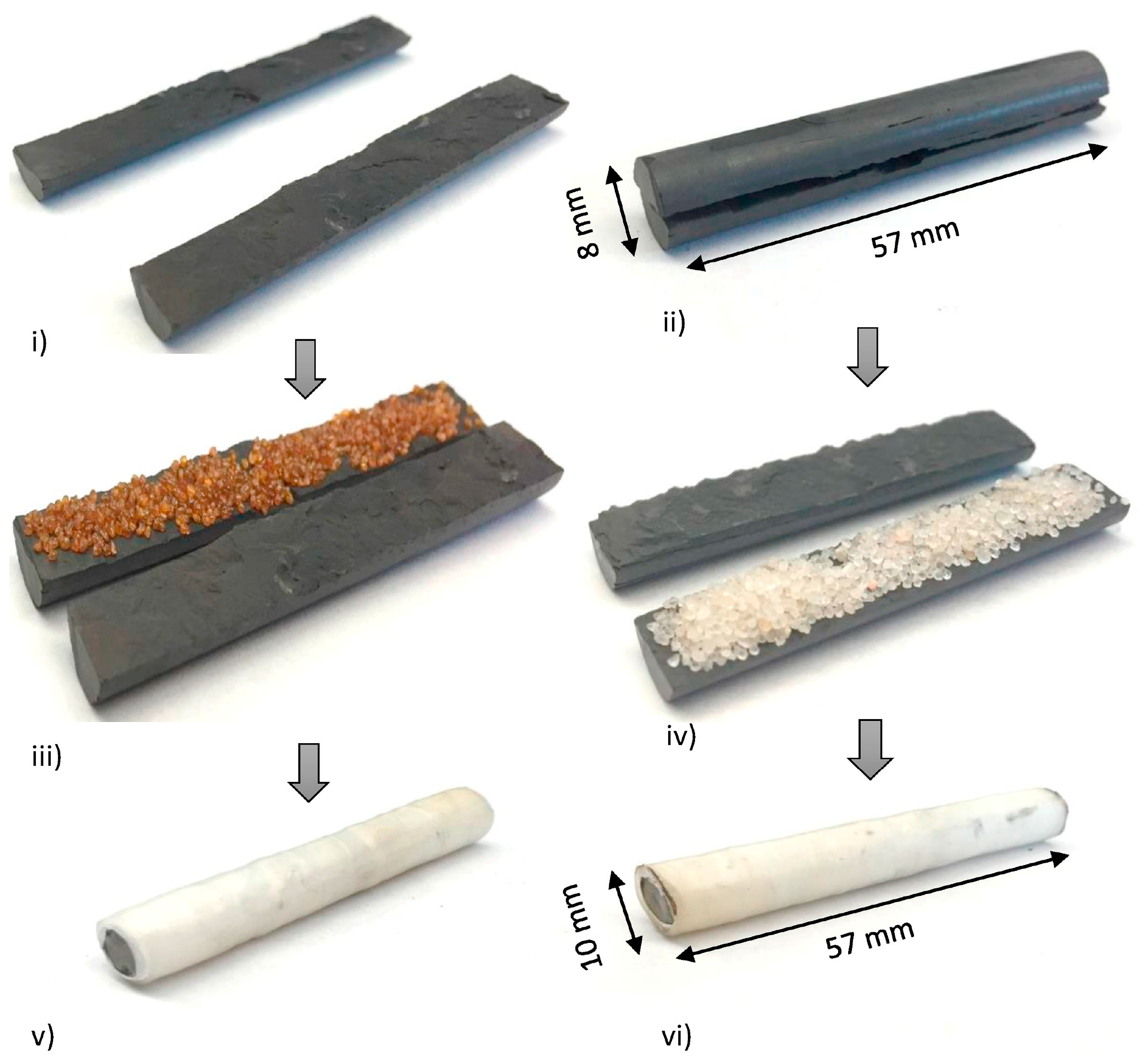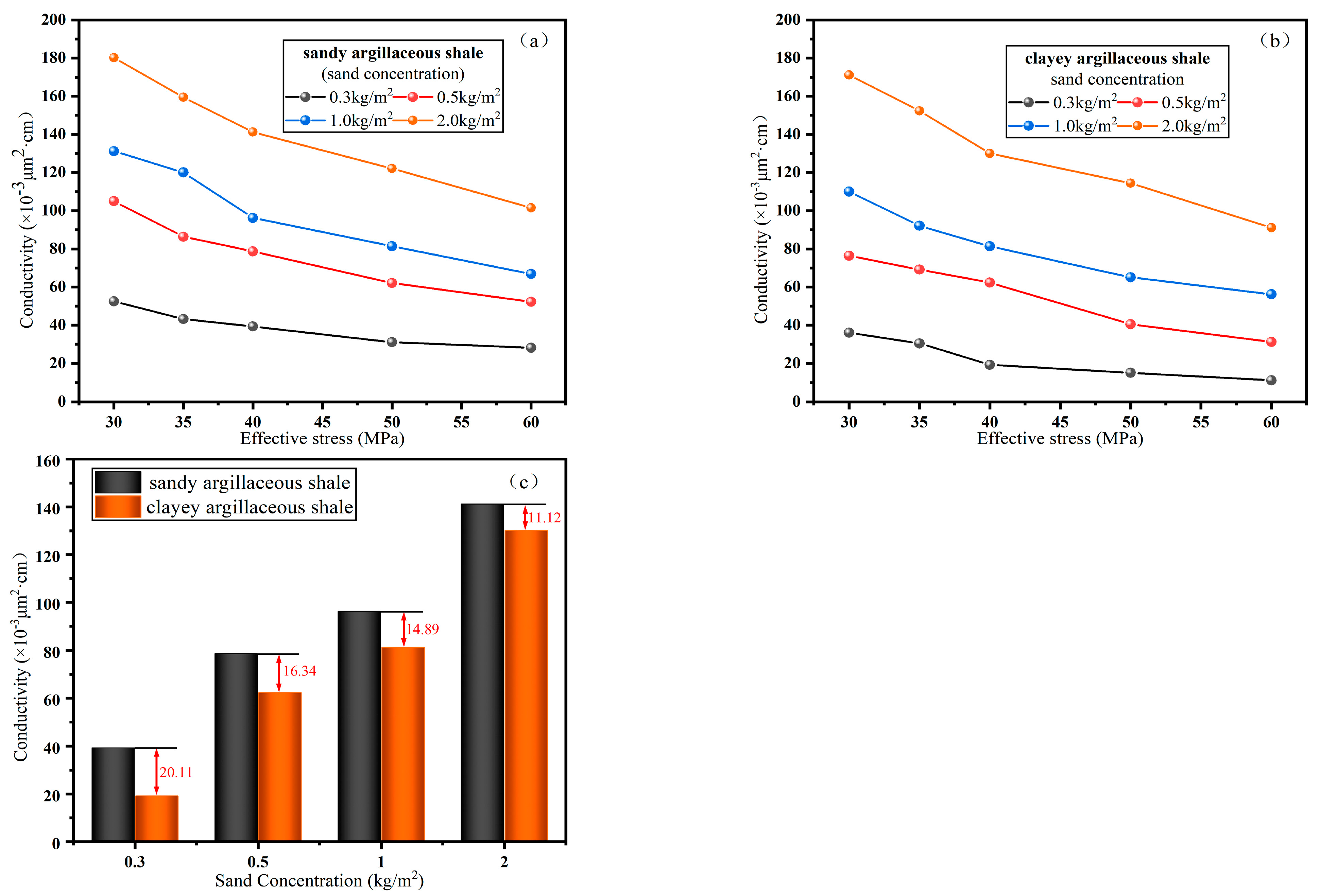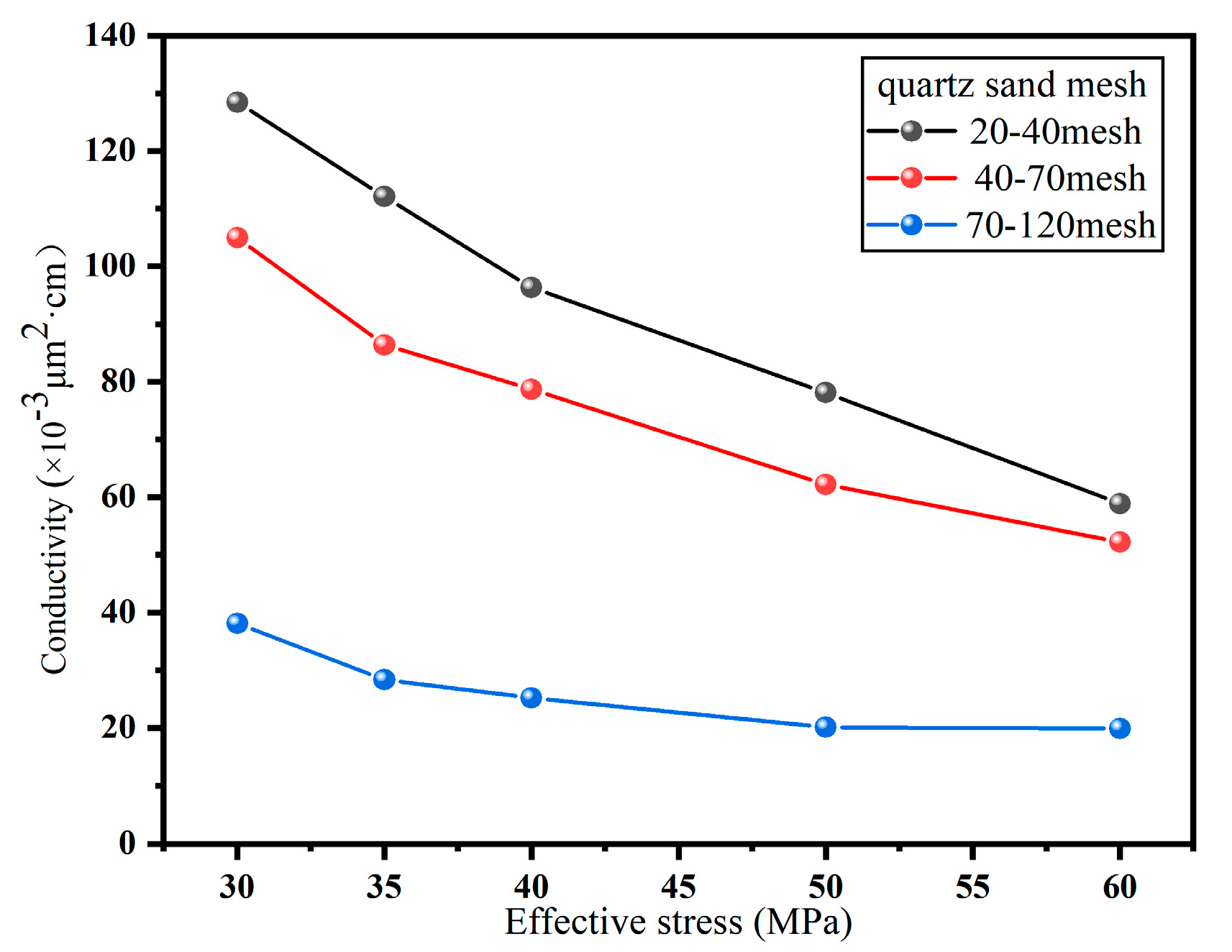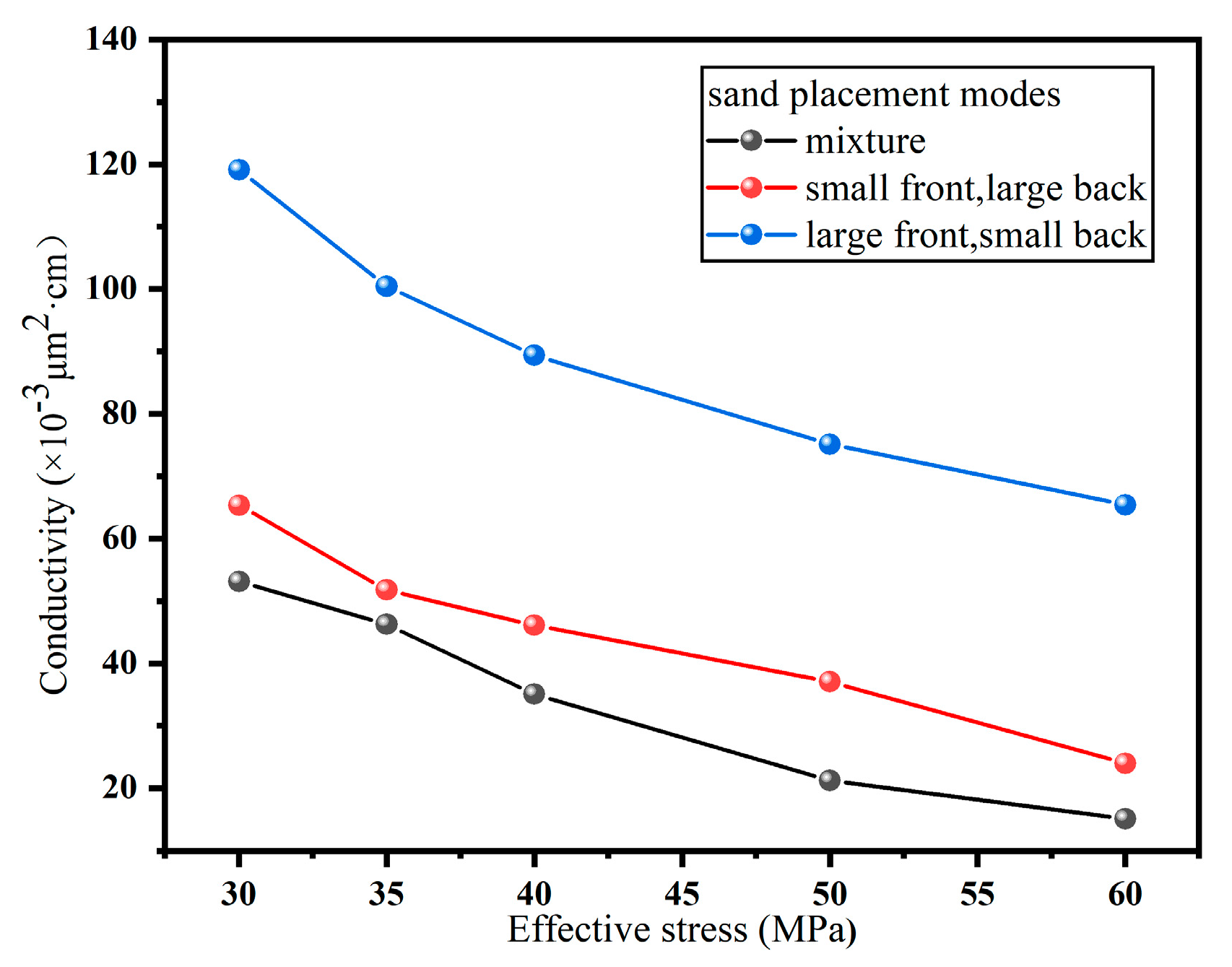Influence of Shale Mineral Composition and Proppant Filling Patterns on Stress Sensitivity in Shale Reservoirs
Abstract
:1. Introduction
2. Experimental Materials and Methods
2.1. Materials
2.2. Petrological Analysis Experiments
2.3. Preparation of Fractured Core with Proppant Fill
2.4. Stress Sensitivity Test Method
- (1)
- Connect the experimental instruments and inspect their sealing integrity.
- (2)
- Place the saturated oil rock core into the high-temperature rock core clamp and set the temperature to 80 degrees Celsius. Once the temperature stabilizes, gradually increase the confining pressure and flow pressure to 80 MPa and 50 MPa, respectively.
- (3)
- Reduced flow pressure stress sensitivity test (simulating the elastic development phase): Maintain the confining pressure at 80 MPa and gradually adjust the flow pressure. The difference between the confining pressure and flow pressure is regarded as the effective stress. By gradually decreasing the fluid pressure, the effective stress sustained by the core gradually increases. Data on stable flow rate and pressure are recorded at effective stress levels of 30, 35, 40, 50, and 60 MPa.
- (4)
- Increased flow pressure stress sensitivity test (simulating replenishment development phase): Maintain the confining pressure at 80 MPa and gradually adjust the flow pressure. Gradually increasing the fluid pressure leads to a gradual decrease in the effective stress sustained by the core. Similarly, data on stable flow rate and pressure are recorded at effective stress levels of 60, 50, 40, 35, and 30 MPa.
3. Results and Discussion
3.1. Mineral Composition and Microstructure of Rocks
3.2. Stress Sensitivity of Natural Core Permeability
3.3. Stress Sensitivity of Fractured Rock Cores with Proppant Fill
3.3.1. Influence of Proppant Concentration and Rock Mineral Composition on Core Conductivity
3.3.2. Impact of Proppant Particle Size and Proppant Filling Patterns on Rock Core Conductivity
4. Conclusions
- (1)
- The natural Jimsar shale cores in Xinjiang are dense with low permeability. The stress sensitivity of pore-type shale cores is weaker, with stress sensitivity coefficients below 0.03, significantly lower than that of fracture-type cores.
- (2)
- The mineral composition of shale also has a significant impact on its stress sensitivity. Clayey argillaceous porous cores exhibit a stronger stress sensitivity compared to sandy argillaceous porous cores. However, due to the propensity of sandy argillaceous cores for particle detachment and clogging of fracture flow channels upon compression of fracture surfaces, the stress sensitivity difference between these two lithologies is not significant in fractured shale core samples.
- (3)
- The increase in electrical conductivity of shale cores due to the filling of proppants is significant. There are differences in the electrical conductivity of cores filled with proppants of different lithologies. At the same proppant concentration, the conductivity of cores from sandy argillaceous shale is higher than that of cores from clayey argillaceous shale. However, as the proppant concentration increases, this difference gradually diminishes.
- (4)
- The larger the particles of the proppants, the stronger their stress sensitivity in terms of electrical conductivity. Proppant concentration also significantly impacts the conductivity of the cores, with higher concentrations resulting in greater conductivity in the fractures. At an effective stress of 60 MPa, the electrical conductivity of cores with a proppant concentration of 2 kg/m2 is 3.61 times that of cores with a proppant concentration of 0.3 kg/m2.
- (5)
- The filling pattern of proppants also has a significant impact on the electrical conductivity of core fractures. When the smaller-grain proppants (70–120 mesh) are placed near the outlet end and the larger-grain proppants (40–70 mesh) near the inlet end, the conductivity is maximized, being 4.33 times that of mixed filling at an effective stress of 60 MPa.
Author Contributions
Funding
Data Availability Statement
Acknowledgments
Conflicts of Interest
References
- Muther, T.; Qureshi, H.A.; Syed, F.I.; Aziz, H.; Siyal, A.; Dahaghi, A.K.; Negahban, S. Unconventional hydrocarbon resources: Geological statistics, petrophysical characterization, and field development strategies. J. Pet. Explor. Prod. Technol. 2022, 12, 1463–1488. [Google Scholar] [CrossRef]
- Zhao, W.; Hu, S.; Hou, L.; Yang, T.; Li, X.; Guo, B.; Yang, Z. Types and resource potential of continental shale oil in China and its boundary with tight oil. Pet. Explor. Dev. 2020, 47, 1–11. [Google Scholar] [CrossRef]
- Zhang, L.; Pan, L.; Zou, Y.; Wang, J.; Li, M.; Feng, W. Recent Advances in Reservoir Stimulation and Enhanced Oil Recovery Technology in Unconventional Reservoirs. Processes 2024, 12, 234. [Google Scholar] [CrossRef]
- Zhou, F.; Su, H.; Liang, X.; Meng, L.; Yuan, L.; Li, X.; Liang, T. Integrated hydraulic fracturing techniques to enhance oil recovery from tight rocks. Pet. Explor. Dev. 2019, 46, 1065–1072. [Google Scholar] [CrossRef]
- Wang, W.; Shahvali, M.; Su, Y. A semi-analytical fractal model for production from tight oil reservoirs with hydraulically fractured horizontal wells. Fuel 2015, 158, 612–618. [Google Scholar] [CrossRef]
- Xu, L.; Zhang, S.; Wang, F.; Ma, X. Study on the productivity of the multi-stage fractured horizontal wells in tight oil reservoirs. Int. J. Oil Gas Coal Technol. 2019, 20, 243. [Google Scholar] [CrossRef]
- Nasehi, M.J.; Mortazavi, A. Effects of in-situ stress regime and intact rock strength parameters on the hydraulic fracturing. J. Pet. Sci. Eng. 2013, 108, 211–221. [Google Scholar] [CrossRef]
- Wu, K.; Olson, J.E. Mechanisms of Simultaneous Hydraulic-Fracture Propagation from Multiple Perforation Clusters in Horizontal Wells. SPE J. 2016, 21, 1000–1008. [Google Scholar] [CrossRef]
- Rhine, T.D.; Loayza, M.P.; Kirkham, B.; Oussoltsev, D.; Altman, R.M.; Viswanathan, A.; Peña, A.; Indriati, S.; Grant, D.; Hanzik, C.; et al. Channel Fracturing in Horizontal Wellbores: The New Edge of Stimulation Techniques in the Eagle Ford Formation. In Proceedings of the SPE Annual Technical Conference and Exhibition, Denver, CO, USA, 30 October–2 November 2011. [Google Scholar]
- Haimson, B.C. The state of stress in the Earth’s crust. Rev. Geophys. 1975, 13, 350–352. [Google Scholar] [CrossRef]
- Dormieux, L.; Jeannin, L.; Gland, N. Homogenized models of stress-sensitive reservoir rocks. Int. J. Eng. Sci. 2011, 49, 386–396. [Google Scholar] [CrossRef]
- Li, X.; Gu, K.; Xu, W.; Song, J.; Pan, H.; Dong, Y.; Yang, X.; You, H.; Wang, L.; Fu, Z.; et al. Effects of Pore Water Content on Stress Sensitivity of Tight Sandstone Oil Reservoirs: A Study of the Mahu Block (Xinjiang Province, China). Processes 2023, 11, 3153. [Google Scholar] [CrossRef]
- Curtis, M.E.; Cardott, B.J.; Sondergeld, C.H.; Rai, C.S. Development of organic porosity in the Woodford Shale with increasing thermal maturity. Int. J. Coal Geol. 2012, 103, 26–31. [Google Scholar] [CrossRef]
- Yang, R.; Jia, A.; He, S.; Wang, T.; Hu, Q. Pore Structure Characterization and Reservoir Quality Evaluation of Analcite-Rich Shale Oil Reservoir from the Bohai Bay Basin. Energy Fuels 2021, 35, 9349–9368. [Google Scholar] [CrossRef]
- He, S.; Li, H.; Qin, Q.; Long, S. Influence of Mineral Compositions on Shale Pore Development of Longmaxi Formation in the Dingshan Area, Southeastern Sichuan Basin, China. Energy Fuels 2021, 35, 10551–10561. [Google Scholar] [CrossRef]
- Xian, S.H.I.; Shu, J.; Shuangfang, L.U.; Zhiliang, H.E.; Dongjie, L.I.; Zhixuan, W.; Dianshi, X. Investigation of mechanical properties of bedded shale by nanoindentation tests: A case study on Lower Silurian Longmaxi Formation of Youyang area in southeast Chongqing, China. Pet. Explor. Dev. 2019, 46, 163–172. [Google Scholar]
- Du, J.; Whittle, A.J.; Hu, L.; Divoux, T.; Meegoda, J.N. Coupling grid nanoindentation and surface chemical analysis to infer the mechanical properties of shale mineral phases. Eng. Geol. 2023, 325, 107304. [Google Scholar] [CrossRef]
- Li, W.; Cao, J.; Shi, C.; Xu, T.; Zhang, H.; Zhang, Y. Shale oil in saline lacustrine systems: A perspective of complex lithologies of fine-grained rocks. Mar. Pet. Geol. 2020, 116, 104351. [Google Scholar] [CrossRef]
- Pang, X.-J.; Wang, G.-W.; Kuang, L.-C.; Lai, J.; Gao, Y.; Zhao, Y.-D.; Li, H.-B.; Wang, S.; Bao, M.; Liu, S.-C.; et al. Prediction of multiscale laminae structure and reservoir quality in fine-grained sedimentary rocks: The Permian Lucaogou Formation in Jimusar Sag, Junggar Basin. Pet. Sci. 2022, 19, 2549–2571. [Google Scholar] [CrossRef]
- Dong, J.-J.; Hsu, J.-Y.; Wu, W.-J.; Shimamoto, T.; Hung, J.-H.; Yeh, E.-C.; Wu, Y.-H.; Sone, H. Stress-dependence of the permeability and porosity of sandstone and shale from TCDP Hole-A. Int. J. Rock Mech. Min. Sci. 2010, 47, 1141–1157. [Google Scholar] [CrossRef]
- Dahl, J.; Nguyen, P.; Dusterhoft, R.; Calvin, J.; Siddiqui, S. Application of Micro-Proppant to Enhance Well Production in Unconventional Reservoirs: Laboratory and Field Results. In Proceedings of the SPE Western Regional Meeting, Garden Grove, CA, USA, 27–30 April 2015. [Google Scholar]
- Ahamed, M.A.A.; Perera, M.S.A.; Elsworth, D.; Ranjith, P.G.; Matthai, S.K.M.; Dong-yin, L. Effective application of proppants during the hydraulic fracturing of coal seam gas reservoirs: Implications from laboratory testings of propped and unpropped coal fractures. Fuel 2021, 304, 121394. [Google Scholar] [CrossRef]
- Yue, M.; Zhu, W.-Y.; Gou, F.-F.; Song, T.-R.; You, Y.-C.; Zhang, Q.-T. Impacts of proppant distribution on development of tight oil reservoirs with threshold pressure gradient. Pet. Sci. 2024, 21, 445–457. [Google Scholar] [CrossRef]
- Mueller, M.; Amro, M. Indentaion Hardness for Improved Proppant Embedment Prediction in Shale Formations. In Proceedings of the SPE European Formation Damage Conference and Exhibition, Budapest, Hungary, 3–5 June 2015. [Google Scholar]
- Arshadi, M.; Zolfaghari, A.; Piri, M.; Al-Muntasheri, G.A.; Sayed, M. The effect of deformation on two-phase flow through proppant-packed fractured shale samples: A micro-scale experimental investigation. Adv. Water Resour. 2017, 105, 108–131. [Google Scholar] [CrossRef]
- Bandara, K.M.A.S.; Ranjith, P.G.; Rathnaweera, T.D.; Wanniarachchi, W.A.M.; Yang, S.Q. Crushing and embedment of proppant packs under cyclic loading: An insight to enhanced unconventional oil/gas recovery. Geosci. Front. 2021, 12, 100970. [Google Scholar] [CrossRef]
- Zhong, Y.; Kuru, E.; Zhang, H.; Kuang, J.; She, J. Effect of Fracturing Fluid/Shale Rock Interaction on the Rock Physical and Mechanical Properties, the Proppant Embedment Depth and the Fracture Conductivity. Rock Mech. Rock Eng. 2019, 52, 1011–1022. [Google Scholar] [CrossRef]
- Guo, S.; Wang, B.; Li, Y.; Hao, H.; Zhang, M.; Liang, T. Impacts of Proppant Flowback on Fracture Conductivity in Different Fracturing Fluids and Flowback Conditions. ACS Omega 2022, 7, 6682–6690. [Google Scholar] [CrossRef]
- Suri, Y.; Islam, S.Z.; Hossain, M. Effect of fracture roughness on the hydrodynamics of proppant transport in hydraulic fractures. J. Nat. Gas Sci. Eng. 2020, 80, 103401. [Google Scholar] [CrossRef]
- Raimbay, A.; Babadagli, T.; Kuru, E.; Develi, K. Quantitative and visual analysis of proppant transport in rough fractures. J. Nat. Gas Sci. Eng. 2016, 33, 1291–1307. [Google Scholar] [CrossRef]
- Arshadi, M.; Piri, M.; Sayed, M. Proppant-packed fractures in shale gas reservoirs: An in-situ investigation of deformation, wettability, and multiphase flow effects. J. Nat. Gas Sci. Eng. 2018, 59, 387–405. [Google Scholar] [CrossRef]
- Kassis, S.; Sondergeld, C.H. Fracture Permeability of Gas Shale: Effects of Roughness, Fracture Offset, Proppant, and Effective Stress. In Proceedings of the International Oil and Gas Conference and Exhibition in China, Beijing, China, 8–10 June 2010. [Google Scholar]
- GB/T 29172-2012; Practices for Core Analysis. Standardization Administration: Beijing, China, 2012.
- Cao, N.; Lei, G. Stress sensitivity of tight reservoirs during pressure loading and unloading process. Pet. Explor. Dev. 2019, 46, 138–144. [Google Scholar] [CrossRef]
- Geng, Y.; Tang, D.; Xu, H.; Tao, S.; Tang, S.; Ma, L.; Zhu, X. Experimental study on permeability stress sensitivity of reconstituted granular coal with different lithotypes. Fuel 2017, 202, 12–22. [Google Scholar] [CrossRef]
- Wang, J.; Hu, Q.; Cai, Z.; Sun, X.; Sun, M.; Zhang, C.; Wei, W.; Cui, Z. Distribution of Retained Oil in Shales from the Lucaogou Formation, Jimusar Sag, Northwest China: Insights from Mineralogy and Pore Structure. Energy Fuels 2023, 37, 11097–11112. [Google Scholar] [CrossRef]
- Louis, C. Rock Hydraulics. In Rock Mechanics; Müller, L., Ed.; Springer: Vienna, Austria, 1972; pp. 299–387. [Google Scholar]
- Wu, J.-B.; Yang, S.-L.; Li, Q.; Yang, K.; Huang, C.; Lin, G.; Lv, D.-P.; Zhou, W.; Colledge, M. Micromechanism and mathematical model of stress sensitivity in tight reservoirs of binary granular medium. Pet. Sci. 2024. [Google Scholar] [CrossRef]
- Duan, X.G.; An, W.G.; Hu, Z.M.; Gao, S.S.; Ye, L.Y. Experimental study on fracture stress sensitivity of Silurian Longmaxi shale formation, Sichuan Basin. Nat. Gas Geosci. 2017, 28, 1416–1424. [Google Scholar]
- Zou, Y.; Shi, S.; Zhang, S.; Yu, T.; Tian, G.; Ma, X.; Zhang, Z. Experimental modeling of sanding fracturing and conductivity of propped fractures in conglomerate: A case study of tight conglomerate of Mahu sag in Junggar Basin, NW China. Pet. Explor. Dev. 2021, 48, 1383–1392. [Google Scholar] [CrossRef]
- Zhang, J.; Ouyang, L.; Hill, A.D.; Zhu, D. Experimental and Numerical Studies of Reduced Fracture Conductivity due to Proppant Embedment in Shale Reservoirs. J. Pet. Sci. Eng. 2015, 130, 37–45. [Google Scholar] [CrossRef]
- Alramahi, B.; Sundberg, M.I. Proppant Embedment and Conductivity of Hydraulic Fractures in Shales. In Proceedings of the 46th U.S. Rock Mechanics/Geomechanics Symposium, Chicago, IL, USA, 24–27 June 2012. [Google Scholar]
- Zheng, W.; Silva, S.C.; Tannant, D.D. Crushing characteristics of four different proppants and implications for fracture conductivity. J. Nat. Gas Sci. Eng. 2018, 53, 125–138. [Google Scholar] [CrossRef]
- Elsarawy, A.M.; Nasr-El-Din, H.A. A new method to measure propped fracture width and proppant porosity in shale fractures. J. Pet. Sci. Eng. 2019, 181, 106162. [Google Scholar] [CrossRef]









| Label | D/cm | L/cm | φ/% | k/md | Lithology |
|---|---|---|---|---|---|
| SA1 | 2.53 | 4.16 | 15.40 | 0.069 | Sandy Argillaceous Shale |
| SA2 | 2.51 | 4.67 | 16.18 | 1.383 | Sandy Argillaceous Shale |
| SA3 | 2.52 | 4.54 | 15.40 | 0.072 | Sandy Argillaceous Shale |
| SA4 | 2.57 | 4.02 | 14.60 | 0.067 | Sandy Argillaceous Shale |
| SA5 | 2.58 | 4.17 | 15.40 | 0.069 | Sandy Argillaceous Shale |
| SA6 | 2.52 | 4.49 | 14.18 | 0.030 | Sandy Argillaceous Shale |
| SA7 | 2.49 | 5.07 | 16.32 | 0.041 | Sandy Argillaceous Shale |
| SA8 | 2.50 | 4.49 | 13.11 | 0.030 | Sandy Argillaceous Shale |
| SA9 | 2.54 | 4.87 | 12.14 | 0.034 | Sandy Argillaceous Shale |
| SA10 | 2.48 | 5.32 | 13.78 | 0.052 | Sandy Argillaceous Shale |
| SA11 | 2.54 | 4.89 | 13.89 | 0.045 | Sandy Argillaceous Shale |
| CA1 | 2.57 | 4.38 | 10.29 | 0.032 | Clayey Argillaceous Shale |
| CA2 | 2.49 | 4.99 | 16.38 | 0.430 | Clayey Argillaceous Shale |
| CA3 | 2.47 | 5.11 | 14.38 | 0.041 | Clayey Argillaceous Shale |
| CA4 | 2.49 | 4.52 | 11.32 | 0.047 | Clayey Argillaceous Shale |
| CA5 | 2.51 | 4.78 | 14.23 | 0.035 | Clayey Argillaceous Shale |
| CA6 | 2.50 | 4.30 | 11.12 | 0.046 | Clayey Argillaceous Shale |
| Case | Core | Proppant | Mesh | Proportion | Sand Concentration, kg/m2 |
|---|---|---|---|---|---|
| 1 | SA3 | Quartz sand | 40–70 | 100% | 0.3 |
| 2 | SA4 | Quartz sand | 40–70 | 100% | 0.5 |
| 3 | SA5 | Quartz sand | 40–70 | 100% | 1.0 |
| 4 | SA6 | Quartz sand | 40–70 | 100% | 2.0 |
| 5 | SA7 | Quartz sand | 20–40 | 100% | 0.5 |
| 6 | SA8 | Quartz sand | 70–120 | 100% | 0.5 |
| 7 | SA9 | Quartz sand | 40–70 (mix) 70–120 (mix) | 50% 50% | 0.76 |
| 8 | SA10 | Quartz sand | 40–70 (front) 70–120 (back) | 50% 50% | 0.76 |
| 9 | SA11 | Quartz sand | 70–120 (front) 40–70 (back) | 50% 50% | 0.76 |
| 10 | CA3 | Quartz sand | 40–70 | 100% | 0.3 |
| 11 | CA4 | Quartz sand | 40–70 | 100% | 0.5 |
| 12 | CA5 | Quartz sand | 40–70 | 100% | 1.0 |
| 13 | CA6 | 4.99 | 40–70 | 100% | 2.0 |
| Label | Clay | Qtz | Kfs | Pl | Cal | Dol | Ank |
|---|---|---|---|---|---|---|---|
| SA1 | 6.3 | 17.8 | — | 23.9 | 6.6 | — | 45.4 |
| SA2 | 4.1 | 12.9 | 13.4 | 14.8 | 8.6 | 46.2 | — |
| SA3 | 7.5 | 21.2 | — | 33.7 | — | — | 37.6 |
| SA4 | 5.8 | 23.1 | 20.6 | 38.3 | — | — | 12.2 |
| SA5 | 6.2 | 18.4 | 23.7 | 30.9 | 8.9 | — | 11.9 |
| SA6 | 4.3 | 23.9 | — | 46.8 | 11.9 | — | 13.1 |
| SA7 | 5.2 | 28.9 | — | 41.3 | — | 13.1 | 11.5 |
| SA8 | 6.1 | 19.8 | 9.9 | 28.8 | 19.6 | — | 15.8 |
| SA9 | 4.3 | 21.5 | — | 36.8 | 8.8 | — | 28.6 |
| SA10 | 5.8 | 13.4 | 6.5 | 31.2 | 4.8 | 38.3 | — |
| SA11 | 4.3 | 14.8 | 10.1 | 27.6 | 8.7 | 13.2 | 21.3 |
| CA1 | 16.9 | 19.4 | 9.9 | 29.7 | 12.8 | — | 11.3 |
| CA2 | 17.8 | 21.0 | 13.8 | 29.5 | 12.3 | 5.6 | — |
| CA3 | 14.9 | 23.3 | 12.0 | 31.2 | 11.2 | 7.4 | — |
| CA4 | 19.8 | 17.9 | 21.2 | 15.8 | 17.1 | — | 8.2 |
| CA5 | 16.5 | 14.7 | 23.8 | 30.2 | 4.1 | — | 10.7 |
| CA6 | 19.3 | 20.4 | 14.8 | 28.5 | 7.8 | — | 9.2 |
Disclaimer/Publisher’s Note: The statements, opinions and data contained in all publications are solely those of the individual author(s) and contributor(s) and not of MDPI and/or the editor(s). MDPI and/or the editor(s) disclaim responsibility for any injury to people or property resulting from any ideas, methods, instructions or products referred to in the content. |
© 2024 by the authors. Licensee MDPI, Basel, Switzerland. This article is an open access article distributed under the terms and conditions of the Creative Commons Attribution (CC BY) license (https://creativecommons.org/licenses/by/4.0/).
Share and Cite
Guo, H.; Wang, Z.; Zhang, Y.; Sun, Y.; Liu, S.; Li, Z.; Liu, Y.; Yang, S.; Zhao, S. Influence of Shale Mineral Composition and Proppant Filling Patterns on Stress Sensitivity in Shale Reservoirs. Processes 2024, 12, 789. https://doi.org/10.3390/pr12040789
Guo H, Wang Z, Zhang Y, Sun Y, Liu S, Li Z, Liu Y, Yang S, Zhao S. Influence of Shale Mineral Composition and Proppant Filling Patterns on Stress Sensitivity in Shale Reservoirs. Processes. 2024; 12(4):789. https://doi.org/10.3390/pr12040789
Chicago/Turabian StyleGuo, Huiying, Ziqiang Wang, Yuankai Zhang, Yating Sun, Sai Liu, Zhen Li, Yubo Liu, Shenglai Yang, and Shuai Zhao. 2024. "Influence of Shale Mineral Composition and Proppant Filling Patterns on Stress Sensitivity in Shale Reservoirs" Processes 12, no. 4: 789. https://doi.org/10.3390/pr12040789




